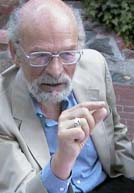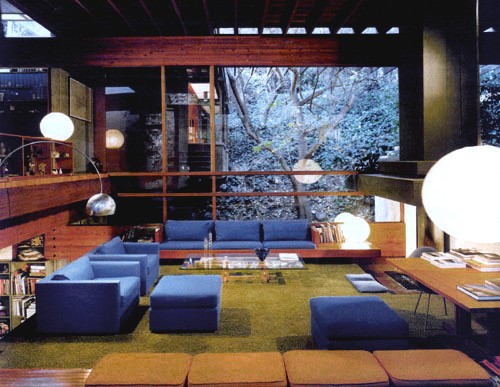














 |
||||
"I've always sought out the edges, the views, and a feeling of expansiveness." "I was once asked what I think are the ten most important principles that helped make me a successful architect, planner, and educator... (1) Think positively, not negatively. (2) Accept structure but know that it is to be questioned and broken when necessary. (3) Always be willing to explore, experiment and invent. Do not accept the status quo. (4) Know yourself and keep your work consistent with who you are and how you think. (5) Maintain good moral and social values. (6) Be humble, honest, compassionate, and egalitarian. (7) Have conviction about your work. (8) Be open and say yes to most ideas and requests. The good ones will be valuable, the bad ones will cease to exist. (9) Allow employees and fellow workers freedom and the ability to work to their strengths. Avoid hierarchy. (10) Money should be the residual of work, not the goal. But do not compromise your worth." |
||||
|
He has
always had a fascination As an
educator, my father will always
|
||||
A TRIBUTE
+ RESOURCE
An internationally recognized architect, urban planner, and educator
since 1953, Ray Kappe's much awarded and published work is considered to
be an extension of the early Southern California master architects:
Wright, Schindler, Neutra, and Harwell Hamilton Harris.
Other Highlights
+ May 2015
article about how Ray Kappe used custom homes over a 60-year
career to pioneer techniques for mass housing
+ November 2012 LA Curbed feature
with 45 color photos
+ September 2012 Palisadian-Post article
+ October 2011 interview
in The Architect's Newspaper.
+ Ray has a Spring 2011 feature
in CA-Modern magazine.
+ Ray conducts a video
tour of his own home in Pacific Palisades.
+ Ray is given the Lifetime Achievement Award in "Stars of
Design 2009" at the Pacific Design Center in West Hollywood,
California.
Designer of a Cultural Heritage Landmark
"Ray
Kappe's 1967 house remains a landmark of nature-friendly modernism."
— Brad Dunning, New York Times

"Ray's own home may be the greatest house in all of
Southern California." — Stephen Kanner, President,
A + D (Architecture + Design) Museum, Los Angeles

Kappe home:
Suspended levels (left), Step-down living room (above)
Reference books —
Themes
& Variations: House Design Ray Kappe Architects/Planners
Brave
New Houses: Adventures in Southern California Living
Modernism
Rediscovered
GA
(Global Architecture) Houses
Other links of interest —
2007
modular project
Collaboration with son Finn,
Project Manager
Ray
Kappe designs one of "AIA Top Ten Green Projects 2007"
2006 modular project (1st
LEED® Platinum Home)
"Curbed
L.A." interview
Ray
Kappe's life's work of drawings + models to be archived at the Getty Research
Institute + secondary article
Slide
show of a Pacific Palisades residence
Benton residence
Collaboration with son Ron, Project
Architect.
Home featured in:
- 2002 movie "One Hour
Photo" starring Robin Williams
-
2007 TV show "Shark"
starring James Woods
-
2007 TV show "Californication"
starring David Duchovny
- An ad run during the Tour de France 2016
Frankel residence
Collaboration with son Ron, Project
Architect
Architecture
+ Design Museum, Los Angeles: Ray Kappe Retrospective
Excerpt from Residential Architect magazine's
2004 Leadership Awards article online —
Hall of Fame: Ray Kappe, FAIA
"Ray Kappe reinvented the house on the hill and architecture education as we know it... [He] is an enormously accomplished architect with a vast portfolio of diverse achievements. But after 50 years of enviable professional successes, there's one task he hasn't yet pulled off: He can't seem to fully retire. Well, you see, people keep knocking at his door with interesting projects in their pockets. There's a prefab community in the California desert and a Modern house in Mexico. And there's a client whose house merits a 25-Year Award because she's kept Kappe working on it for nearly that long. The house is so gorgeous, it's in constant demand as a backdrop for television commercials. Still, it's a work in perpetual progress. So, too, is Ray Kappe.
The Los Angeles-based architect has never been one to rest on laurels, even though his collection is ample. Among them are lifetime achievement awards for himself and 25-Year Awards for his house from both the American Institute of Architects California Council and AIA's Los Angeles Chapter. AIA National and the Association of Collegiate Schools of Architecture honored him with their Topaz Medallion for his work founding and directing the Southern California Institute of Architecture (SCI-Arc). And the walls of his [office] are chockablock with design awards. He certainly deserves to sit back and enjoy the accolades, and he fully intends to after he finishes these few projects on the boards. Yes, indeed.
Against type
Kappe started experimenting with housing in the early 1950s, the height of
mid-century Modernism. Some architects of the time zeroed in on a style
and proceeded to hone it over a lifetime, but Kappe has continued to
experiment, always excited to try something new. That's why he eschews the
label of Modernist. He doesn't wish to be pigeonholed by a word that now
represents in the public mind a fixed period on the architectural
timeline. He doesn't mind being called a modern architect, however, with
that lower case "m" signifying an ongoing desire to try
innovative ideas, technologies, and materials.
With his disdain for typecasting, Kappe hasn't attracted as much attention for his design work as some other Los Angeles-based architects have enjoyed. He's also designed largely in wood and has done a few pitched roofs, no-no's for some Modern purists. "Some of my clients wanted pitched roofs, so I experimented with long, low gables. And most of my clients didn't want steel," he says. Despite the trespasses, his houses are just as beautiful as those Case Study tours de force, perhaps even more so because they're far more livable. They marry Modernism's love of open floor plans, indoor-outdoor connections, and manipulations of space for dramatic effect with a deep respect for the site and the intimate relationship between human beings and their built environments. "You know, architecture doesn't have to do it all. The natural layer should show through too," he says.
After graduation from the University of California, Berkeley in 1951, Kappe cut his housing teeth working for the San Francisco firm of Anshen + Allen, a designer of Eichler houses, and Los Angeles-based architect Carl Maston, with whom he designed apartment buildings. But he soon hung out his shingle as a solo practitioner, eager to tap the post-World War II housing boom and its remarkable tolerance for new ideas. He settled in Sherman Oaks and built his first houses in the San Fernando Valley. They were open-plan, post-and-beam suburban houses designed to exploit Southern California's temperate climate. Bedrooms were small, with most square footage applied to living areas that opened to patios. "They were all about getting as much feeling of space as possible," he says. "As a kid, my mother would find me sitting in the open window of our apartment building. I've always sought out the edges, the views, and a feeling of expansiveness. That's the common denominator in my architecture."
Home schooling
Kappe has completed some 100 single-family houses over the years, but his
tour de force is his own house in Pacific Palisades. Built in 1968, it's
the best example of his strength as an architect: his ability to answer
complex design problems with inventive, beautiful buildings. The biggest
problems on the project were a steeply sloped site and a running stream.
His answer was a series of six concrete tower supports and a bridgework of
laminated beams. The house tiptoed over the site, sparing trees, stream,
and the delicate beauty of the topography. "Developers at the time
were cutting hills to make pads. I'd been working on the idea of a system
of modules to get buildings above grade," he says. "Many of my
houses ended up using this system because it required the least amount of
foundation."
Throughout his career, Kappe has explored many avenues of interest to his inquisitive mind, all the while continuing his residential practice. He was especially drawn to urban planning and co-founded a collaborative, Kahn Kappe Lotery [Boccato] Architects Planners, to work on those projects and others. He taught design at the University of Southern California and in 1968 founded the architecture department at California Polytechnic State University at Pomona (Cal Poly). After a falling out with Cal Poly's administration three years later, he left with a few of his teachers, some of his students, and his wife, Shelly, also a teacher and his great partner in life, to start SCI-Arc. He directed the school—which quickly became famous for its free-thinking and freewheeling creativity—until 1987.
Somehow during his trailblazing work in
architecture education, Kappe still found time to design houses. "I
think it's easier to do a lot than a little," he explains. "You
use your support better. And I always designed quickly. Houses were a
great laboratory for experimenting with design and construction
ideas." Over the years, he's employed and trained many SCI-Arc
students who've gone on to make names for themselves, among them his sons
Ron and Finn, both residential architects. And today he works on his own
again, a one-man shop just as he was in 1953. "I'm no different in my
mind than when I first started," he says. "I'm doing the kinds
of things now I would have done 50 years ago. I feel like a 25-year-old."








